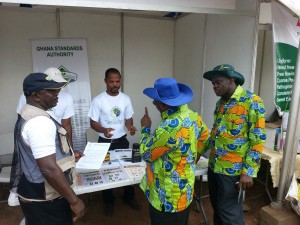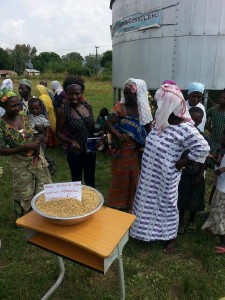Delivering moisture testing to growers: calibrating practices to match science
By William Lanier, NeverIdle Farms Consulting, Ghana

GSA and AESD with Crops (MoFA) discussion “Stop PHL: Let’s Eat What We Grow” theme NFDC 2013, Sogakope / William Lanier
This post is part of the ADM Institute’s #PreventPHL blog campaign, following up on the First International Congress on Postharvest Loss Prevention. To read more posts in the series, click here.
The 2015 PHL Congress needed only 3 days in Rome to bullet “Deliver moisture testing to growers.” Soon after, Dr. Dirk Maier moderated the “Drying and Storage” breakout which entertained comments about how impractical staple grain storage is without moisture testing. Also mentioned were the differences between the science standards and protocol practices used to calibrate moisture meters. Calibrations that do not standardize may reduce the meaning of approaches and intervention strategies to reduce mycotoxins and other PHL.
African Regional Standards Organization supports Ghana Standards Authority (GSA) to standardize handheld and other moisture testers and meet a “Statutory mandate to verify and calibrate all weighing and measurement instruments used for trade in Ghana” and so, “All warehouses involved in the Warehouse Receipt System (WRS) must use moisture meters to determine the moisture content and weighing instruments to establish the weight of maize before receiving into the facility. These instruments should be calibrated first prior to being used for this trading activity” (Crentils, 2013).
Northern Ghana welcomes various moisture meters from many donor production packages. However, production package testimonials rarely mention calibrated moisture meters and so the results of many various tests may not have meaning to growers.
The multimillion production packages include WRS that “even if they did work, they would not help smallholders, which they are often claimed to do” (World Bank/Ferris, 2013.) Due diligence and barrier analysis by small business suggest that WRS practice protocol more often than standards (Lanier, 2015).
Is the PHL Community of Practice aware of
- at harvest approaches to support standards that help growers navigate WRS protocol?
- market interventions that discount WRS protocol and add meaning to standards?
- “Behavior Change Strategy” (Kenny, 2015) to help WRS adopt standards?

Diana MT&S with exhibitors at NFDC 2014, Aframso / William Lanier
One approach to reduce PHL with moisture testing, was scaled up in August 2013 when “Diana’s Moisture testing and Solarization” (MT&S) business began providing the Ashanti region of Ghana with GSA calibrated moisture testing. Moisture testing extends beyond food grain, because purchasing seed with correct moisture levels reduces poor germination tests later. Diana is ready to travel to fields being harvested by mechanical combines and test for moisture problems. GSA calibration has been presented by Diana’s MT&S at National Farmer’s Day celebrations (MoFA).
Anyone using the large cup screw on lid type meters to test and market bags or sacks will appreciate the probe type Armstrong PHL meter that is “an easy, low-cost method to measure moisture of several different grains stored in bags” (McNeill, 2015).
Given that moisture meters and standards already exist, why are they not adding meaning to production and changing the game by “having a large, positive and immediate impact in mitigating mycotoxin problems” (McNeill, 2015) and “empower women [like Diana] in their roles, reduce PHL, and improve the well-being of their families” (Kenney, 2015)?
References:
Crentils, G., 2013. Letter to Minister of Crops [GSA/MED 114.14/V.4/40, 2013-09-12] Ghana Standards Authority Moisture testing lab, Accra, Ghana.
Kenney, G., (September 2015). Women and Postharvest Loss [PHL Community of Practice Blog post]. Retrieved: <http://publish.illinois.edu/phlinstitute>.
Cernansky, R (October 2015). A Silent Scourge Is Wiping Out Crops in Africa. [takepart World Series] Retrieved: <https://www.takepart.com/article/2015/10/5/reducing-post-harvest-food-loss-africa?>.
Lanier, Salifu, Parker (2015). A Qualitative Discussion about the Utility of Staple Grain Logistical Platforms in Ghana, West Africa [ADM Congress Presentation]. Retrieved <http://phlcongress.illinois.edu>.
McNeill, Armstrong, Osekre (2015). Assessment of Moisture Measurement and Maize Dryers in Ghana [ADM Congress Presentation]. Retrieved <http://phlcongress.illinois.edu>.
World Bank/Ferris, S., (2013). Postharvest Loss: The Case of Missing Food in Sub-Saharan Africa [Text box 3.5]. Retrieved <www.fao.org/ag/ags/ags-division/publications/publication/en/c/81559/>.
The blog entries in this #PreventPHL series are by students and members of the PHL Prevention community of practice. The opinions expressed are those of the individual authors and do not necessarily reflect the position of the ADM Institute. In addition, none of the statements should be considered an endorsement of any person, product, or technique by the ADM Institute.



Add Comment